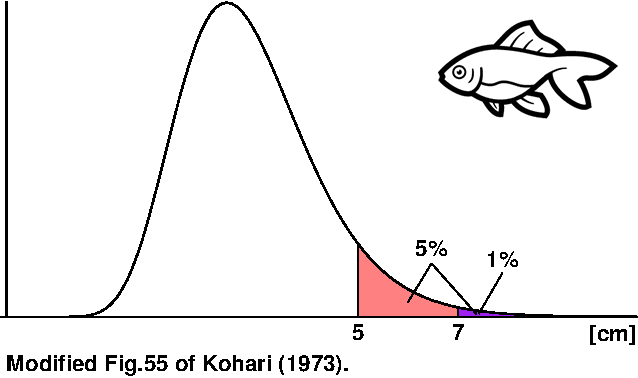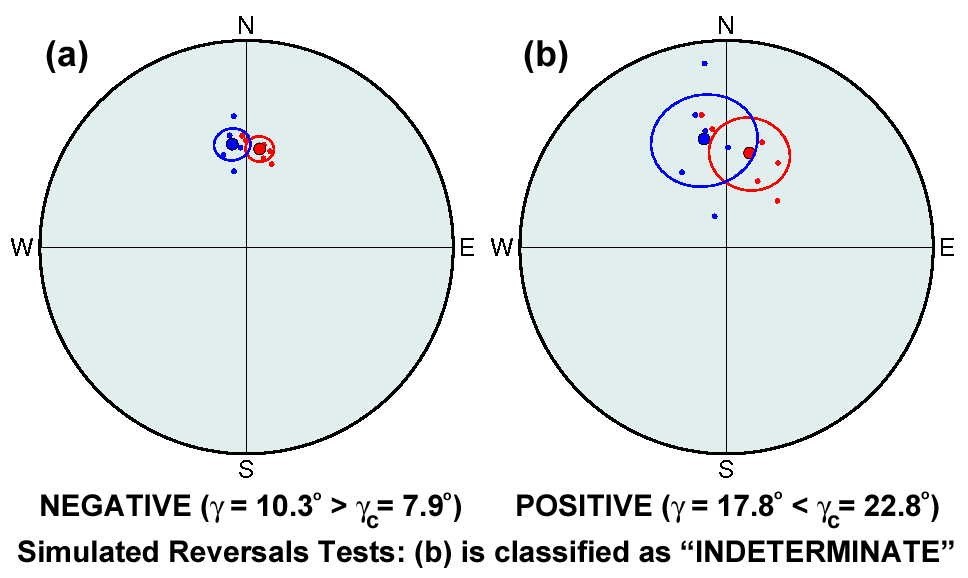 Statistical Tests
Statistical Tests
Statistical tests are widely used in any fields of science, and paleomagnetism is no exception. In the procedure of a statistical test, we first assume a certain matter concerning to the observation which is called a null hypothesis. Next we estimate the probability of the observation to occur under the hypothesis. If the probability is lower than a certain value \(\alpha\), we reject the hypothesis. The critical probability \(\alpha\) is called a significance level, or a risk of error, and usually 5% is taken. The following is an example of the simplest statistical test taken from Kohari (1973).
Suppose that the distribution of the body length of goldfish, bred at a fish farm A, is known as the figure below. It is well established that the proportion of the goldfish whose body length is 5 cm or longer is 5%, and those with 7 cm or longer is 1%.

Now suppose that somebody brought a gold fish of the same species whose body length is 6 cm. We test whether this gold fish is from the fish farm A or not. We assume the next null hypothesis.
Under hypothesis H, the probability to obtain a gold fish with 6 cm length is smaller than 5 %. Hence we reject hypothesis H with 5 % significance level (risk of error) and conclude that the gold fish is not from the fish farm A. However, if you are further asked about the sureness of the conclusion, you would answer that it is not so sure with 1 % risk of error, i.e. hypothesis H cannot be rejected with 1% significance level. In other words, we can say that this gold fish is not from the fish farm A with 95% confidence, but cannot say so with 99% confidence.
Here, it is important to point out that we can say nothing when hypothesis H cannot be rejected. For instance, for a gold fish with 4.5 cm length we cannot reject that "this gold fish is from the fish farm A". However, this does not warrant that we can say "this gold fish is from the fish farm A". The gold fish might be from the fish farm A or might be from other fish farms where the body length distributions are different. The null hypothesis works only when it is rejected and disappears when it is not rejected. This is why the hypothesis is called "null" hypothesis.
This is the reason that, in paleomagnetism, McFadden & McElhinny (1990) proposed to classify the results of the "reversals test". Reversals test is to test whether normal and reversed paleodirections share a common mean direction when the latter are inverted by 180°. In paleomagnetism, we suppose that the time averaged paleomagnetic direction, obtained from collectively normal and reversed directions, coincides with that of a geocentric axial dipole field if the observation time is long enough. This concept is called the geocentric axial dipole (GAD) hypothesis. Hence, if the reversals test fails, it is suspected that rock collection was not large enough to cover necessary time span. Another cause of the failure might be contamination of a secondary remanence which would shift both normal and reversed directions to that of the secondary component, and they would no longer be antipodal.
To carry out a reversals test, the following null hypothesis is assumed after inverting the reversed directions.
Two simulated reversals tests are shown in the figure below where red and blue colors indicate normal and reversed data, respectively. A small circle is each paleodirection and a larger circle is the mean direction for each polarity. Circles of 95% confidence for the means are also drawn.

Figure (a) is a case of negative reversals test, i.e. hypothesis H was rejected with 5% significance level. Hence, we can say that the two mean directions are different with 95% confidence. On the other hand, hypothesis H was not rejected in the case of (b). Hence, we can say nothing about the difference of the mean directions. Nevertheless, in paleomagnetism we traditionally claim that the reversals test was positive.
The difference angle \(\gamma\) of the two mean directions is smaller in (a) (10.3°) than in (b) (17.8°), and yet the reversals test failed in (a) while it passed in (b). In the test of a common mean direction, hypothesis H is rejected when \(\gamma\) is larger than a critical angle \(\gamma_c\) corresponding to a specified significance level. In the case of (b), \(\gamma_c\) with significance level of 5% is as large as 22.8° and this is caused by the large errors of the mean directions. Hence, it is not appropriate to claim that the two distributions shown in (b) share a common mean.
Considering the fact that reversals tests similar to the above example had often been reported, McFadden & McElhinny (1990) proposed to classify the positive reversals tests according to the amount of \(\gamma_c\): 'A' if \(\gamma_c\)≤5°, 'B' if 5°<\(\gamma_c\)≤10°, 'C' if 10°<\(\gamma_c\)≤20°, and 'INDETERMINATE' if \(\gamma_c\)>20°. Although these recommended breakpoints of \(\gamma_c\) lack any statistical grounds, they will be useful to evaluate a reversals test reported as positive.
Programs of statistical tests
The following four programs are available.
- "tmean": test of a common mean for two scalar data sets.
- "tmeandir": test of a common mean direction for two or more groups of unit vectors.
- "histo": test of distribution for one data set.
- "histo2": test of distribution for two data sets.
"tmean" and "tmeandir" are working on "Ubuntu 22.04" in which "gcc 11.4.0" is installed. They should work on other Linux environment as long as recent version of gcc is installed.
"histo" and "histo2" use classic mode of GMT 6 (compatible with GMT 5) to create a PostScript file of histograms. They are working on the above mentioned system with "GMT 6.3.0" installed (those with GMT 5.4 should be OK).
Download and installation of the program
- "tmean" and "tmeandir": → See this page.
- "histo" and "histo2": → See this page.
References:
- Kohari, A., Introduction to Probability and Statistics, 300 pp., Iwanami Shoten Pub., Tokyo, 1973. (in Japanese)
- McFadden, P. L., and M. W. McElhinny, Classification of the reversal test in palaeomagnetism, Geophys. J. Int., 103, 725-729, 1990.